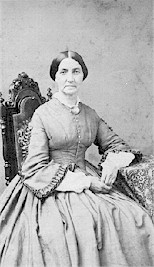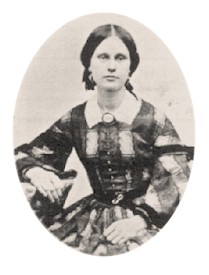UNDERPINNINGS: Cotton drawers, petticoats for
under and over the hoops, cage crinoline, corded petticoat, chemise,
corset, stays, cotton stockings, undersleeves for open sleeve garments,
etc. All should be of 100% cotton. Underpinnings should be white, may
be trimmed with embroidery, tucks, white cotton lace or Broderie Anglais.
Stockings: Generally were white, natural, or
other colors, sometimes stripes, and during the period were worn over
the knee with garters - this is optional.
Chemise: Loose fitting short sleeve shift
reaching below the knee. May double as a nightgown. Provides a
modesty barrier for open crotch drawers.
Drawers: Period drawers were full-cut tubes
attached to a band; hems come to between midcalf and just below the
knee. The crotch was left open for convenience in using the privy in
the 1860's - this is optional.
Petticoats: Made from white cotton, preferably
starched in boiled starch. Quilted or wool flannel petticoats can
provide warmth when needed. Petticoats should be 2-4 in. shorter than
the skirts.
Corset: Made of heavy material such as drill,
it is "boned" with metal "stays" and closes with a busk in front and
laces in back. A corset is obviously apparent to seasoned re-enactors
in providing the proper silhouette and posture. It provides support
for the bust, back and hoop. The corset is worn over the chemise
which helps protect the corset from perspiration. A corset has a
space of about 3-4 inches at the lacings allowing for adjustment.
Many myths are circulated about tiny waists produced from corsets -
this is discouraged.
Hoop/Cage: Supports the skirt for a
dressier look. Generally not worn for work. Should be bell-shaped,
size may vary somewhat, but large sutler hoops are incorrect.
Collars, Cuffs, and
undersleeves: Worn to protect clothing from perspiration so that it
did not have to be laundered as often. Collars of 1 inch are
acceptable for our period.
DRESSES: Please refer to new member guidelines.
Silk, cotton, and wool might be considered. Bodices and skirts should
match. Most dresses have round or jewel necklines and close with hooks
and eyes or buttons. Buttons were sometimes used as trim for dresses
which actually closed with hooks and eyes. Seams which carry the weight
of the dress may be piped using same fabric. Dresses were hung by two
large loops - not coat hangers. A day dress might be considered and a
ball gown if the wearer wishes. These might have some trim and be cut
fuller than a work dress. Fabrics might be more elaborate. Ball gowns
may lace up the back if desired.
APRONS: A veteran re-enactor might have one or
more aprons for use around camp. These should be cut full and shorter
than the dress. Wool aprons shield the legs from heat while cooking and
do not absorb as much water. Large pockets are acceptable.
OUTERWEAR: Knitted shawls were popular and might
have decorative borders. Capes should not have gathers around the neck
but flow flat across the shoulders. 100% wool yarn is recommended for
shawls and knitted items when possible.
A palentote might be added to the wardrobe for
warmth and as an alternative to a cape. These varied from below the hip
to just shorter than the dress.
GLOVES: Worn for social visits, church, dances,
etc. Kid gloves for a better look, cotton was acceptable for most
impressions, especially rural Southern women. Gloves worn during the day
might be of colors, evening wear calls for white gloves.
HEAD COVERINGS: Sunbonnets, corded or slat
bonnets are excellent choices for many impressions. Better bonnets
might be a spoon, straw, or cottage bonnet. Hairnets when worn at all
were used over fully dressed hair. These "nets" were made of ribbon or
crochet with beads, flowers, fringe, or bows as trim. Nets sold by
sutlers and referred to as "snoods" are inappropriate. Ties on spoon or
straw bonnets should be wide. The feelings was if you could only afford
one good bonnet it should be straw. Hats were generally worn by younger
women and teens, and were oval in shape, not round. Bonnets were
generally not matched to any particular dress.
Hairstyles were universally parted in the middle,
pulled back into a bun at ear level or hair line. Bants were not worn
and if the wearer has them they should be twisted in with the hair in
front before putting the hair up. Sausage curls were generally worn by
girls and older women. Girls and young ladies sometimes wore shorter
hair but it was still parted in the middle.
Morning caps were worn in the
1850's and had fallen out of use by 1861.
PARASOLS: Glenna
Jo Christen offers a parasol with folding handles like originals.
HANDKERCHIEFS: Women of the period had many -
larger sizes - approximately 19-20 in. of lightweight fabric, and may be
edged in cotton lace or embroidered.
FANS: Widely used. Lengths were generally 6 to 8
in. - the longer styles came into use later in the Victorian period.
Styles varied from straw to paper and wooden handles sometimes had
openings carved in them for the fan to fold into when closed. A feather
fan might be considered. A straw or palmetto fan might be used by a
gentleman.
RETICULES: May be made from plain fabric or
something as nice as silk, brocade or velvet which might be coordinated
with a better dress.
FOOTWARE: Women generally wore boots or shoes
with square toes. They might lace on the front or side and might have
elastic bands in the sides (this was one case where elastic was used).
Heels were 1" or less. Reproduction shoes and boots are available and
may be ordered to suit your color preference. They may have elastic
sides, laces, or buttons. Excellent leather brogans and boots (for men
and women) may be ordered from Lincoln Log Cabin at 400 S. Lincoln Hwy.
Rd., P.O. Box 100, Lerna, IL 62440. Phone 2l7-345-l845. E-mail leslie@lincolnlogcabin.org.
Web site: http://www.lincolnlogcabin.org. For the ladies they offer
both a high top and low top brogan in red, brown, or black.
BUTTONS: China, calico, wooden, india rubber,
jet, black glass, pearl, bone, cut glass, mother-of-pearl, etc. were
available. Southern women also fashioned ersatz buttons. Many of these
must be removed to launder a garment.
JEWELRY: Brooches, lockets, cameos, earrings with
French wires, bracelets - sometimes matching bracelets worn on each arm
are appropriate.

